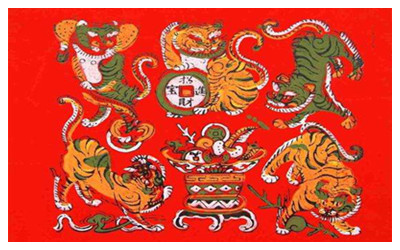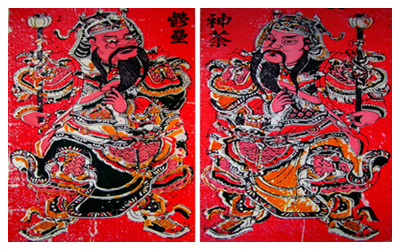- Home
- Travel In China > China Culture > Chinese Handicrafts >
Zhangzhou Woodblock New Year Pictures
Zhangzhou
Woodblock New Year pictures is a kind of Chinese traditional folk art, which began in the Song Dynasty and flourished in the Ming and Qing Dynasties.It is popular in the
Xiangcheng District in Zhangzhou City, the Southern Fujian, and are often sold in Taiwan, Hong Kong, and Southeast Asia.

The book-printing industry thrived in Fujian in the Song Dynasty, which led to the rapid development of civil printmaking. In the Ming and Qing Dynasties, Zhangzhou New Year wood-block prints began to gain popularity, and the rising of the Yuegang Port in Zhangzhou facilitated the export of such products. In the early 20th century, a large number of new year prints stores concentrated along Lianzi Street, Hong Kong Road and Taiwan Road in Zhangzhou, and a few of them remained until the 1950s.
A variety of folk activities have provided soil for the survival and development of the Zhangzhou New Year wood-block prints industry. The themes of Zhangzhou wood-block prints mainly relate to symbols warding off evil, marks of blessings, historical stories in dramas, and decorative patterns. Most Zhangzhou New Year prints are door-god paintings, which are divided into Cushen, Youshen, Wenshen and Wushen. Cushen refers to door paintings printed on bright red or vermeil paper; Youshen refers to door paintings directly printed on unbleached paper, with the background overprinted with pink (mixed color) later; Wenshen refers to door paintings on which figures do not ride a horse nor carry flags; Wushen, on the contrary, features figures riding a horse or carrying flags.
For Zhangzhou New Year wood-block prints, drawings are first engraved on wood-blocks (including coloring block and outline block), then overprinted on the paper using wood-block printing. The engraving is divided into positive engravings and negative engravings. The ones used to print the background color for characters in Youshen are negative engravings, the carving and usage of which is unique in China. All lines and color blocks on the engraving are designed with outward edges, which facilitate the adjustment of water during the printing. Overprinting is used by applying color engravings and ink line engravings successively to provide a compelling effect. Pear wood is usually selected as material for engraving, but acacia wood, Chinese oak and pomegranate are alternatives too. In regards to the paper, only Minxi paper is used, such as Fushu paper in Longyan City, Yvkou paper in Changting County,
Shanghang County and Gutian County, and foil paper in
Qingliu County.

In Zhangzhou, wood-block printing workshops are divided into the "red house" and the "dark house". The "dark house" refers to those dedicated to book printing, while the "red house" refers to those specialized in printing New Year pictures. Quite frequently, workshop owners are both the drawer and the engraver, or at least take one of the two key positions, while handymen are hired for odd jobs. The Yan’s Workshop in late
Qing Dynasty, by merging a number of smaller workshops, successfully brought together a large number of older engravings and contemporary new engravings, forming an unprecedented collection of different works. In 1957, Yan
Jingming, a descendant of the Yan's, chose to practice medicine after donating all of the workshop and store properties to the government.
With the deepening of social transformation, the traditional awareness is gradually fading away and folk activities have begun to change as a result. Without the support of local customs, Zhangzhou New Year wood-block prints have shifted focus to having an ornamental purpose, significantly weakening the practicality of warding off evil and inviting blessings. All these factors have contributed to a market slump. In face of a shrinking market, people engaged in production of wood-block paints are becoming fewer in number. Therefore, specific measures should be taken as soon as possible to protect and rescue the Zhangzhou New Year wood-block prints and their processes from the brink of extinction.
On May 20, 2006, Zhangzhou woodblock New Year picture was included in the first batch of national intangible cultural heritage lists of the People's Republic of
China. In November 2019, Zhangzhou City Art Museum is the protection unit of Zhangzhou woodblock new year prints project.

 The book-printing industry thrived in Fujian in the Song Dynasty, which led to the rapid development of civil printmaking. In the Ming and Qing Dynasties, Zhangzhou New Year wood-block prints began to gain popularity, and the rising of the Yuegang Port in Zhangzhou facilitated the export of such products. In the early 20th century, a large number of new year prints stores concentrated along Lianzi Street, Hong Kong Road and Taiwan Road in Zhangzhou, and a few of them remained until the 1950s.
The book-printing industry thrived in Fujian in the Song Dynasty, which led to the rapid development of civil printmaking. In the Ming and Qing Dynasties, Zhangzhou New Year wood-block prints began to gain popularity, and the rising of the Yuegang Port in Zhangzhou facilitated the export of such products. In the early 20th century, a large number of new year prints stores concentrated along Lianzi Street, Hong Kong Road and Taiwan Road in Zhangzhou, and a few of them remained until the 1950s. In Zhangzhou, wood-block printing workshops are divided into the "red house" and the "dark house". The "dark house" refers to those dedicated to book printing, while the "red house" refers to those specialized in printing New Year pictures. Quite frequently, workshop owners are both the drawer and the engraver, or at least take one of the two key positions, while handymen are hired for odd jobs. The Yan’s Workshop in late Qing Dynasty, by merging a number of smaller workshops, successfully brought together a large number of older engravings and contemporary new engravings, forming an unprecedented collection of different works. In 1957, Yan Jingming, a descendant of the Yan's, chose to practice medicine after donating all of the workshop and store properties to the government.
In Zhangzhou, wood-block printing workshops are divided into the "red house" and the "dark house". The "dark house" refers to those dedicated to book printing, while the "red house" refers to those specialized in printing New Year pictures. Quite frequently, workshop owners are both the drawer and the engraver, or at least take one of the two key positions, while handymen are hired for odd jobs. The Yan’s Workshop in late Qing Dynasty, by merging a number of smaller workshops, successfully brought together a large number of older engravings and contemporary new engravings, forming an unprecedented collection of different works. In 1957, Yan Jingming, a descendant of the Yan's, chose to practice medicine after donating all of the workshop and store properties to the government. Ask Questions ?
Ask Questions ?